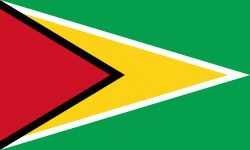Upper Demerara-Berbice (Upper Demerara-Berbice Region)
Upper Demerara-Berbice (Region 10) is a region of Guyana, bordering the regions of Essequibo Islands-West Demerara, Demerara-Mahaica and Mahaica-Berbice to the north, the region of East Berbice-Corentyne to the east, and the regions of Potaro-Siparuni and Cuyuni-Mazaruni to the west.
It contains Guyana's second largest city, Linden, with notable villages including Ituni, Kwakwani, Kurupukari, Rockstone and Takama.
Kimbia is the first training center to house the Guyana National Service. The Pioneer Corps was started in 1974, with the establishment of Kimbia Center on the Berbice River.
The Government of Guyana has administered three official censuses since the 1980 administrative reforms, in 1980, 1991 and 2002. In 2012, the population of Upper Demerara-Berbice was recorded at 39,452 people. Official census records for the population of the Upper Demerara-Berbice region are as follows:
* 2012 : 39,452
* 2002 : 41,112
* 1991 : 39,608
* 1980 : 38,641
It contains Guyana's second largest city, Linden, with notable villages including Ituni, Kwakwani, Kurupukari, Rockstone and Takama.
Kimbia is the first training center to house the Guyana National Service. The Pioneer Corps was started in 1974, with the establishment of Kimbia Center on the Berbice River.
The Government of Guyana has administered three official censuses since the 1980 administrative reforms, in 1980, 1991 and 2002. In 2012, the population of Upper Demerara-Berbice was recorded at 39,452 people. Official census records for the population of the Upper Demerara-Berbice region are as follows:
* 2012 : 39,452
* 2002 : 41,112
* 1991 : 39,608
* 1980 : 38,641
Map - Upper Demerara-Berbice (Upper Demerara-Berbice Region)
Map
Country - Guyana
 |
 |
| Flag of Guyana | |
The region known as "the Guianas" consists of the large shield landmass north of the Amazon River and east of the Orinoco River known as the "land of many waters". Nine indigenous tribes reside in Guyana: the Wai Wai, Macushi, Patamona, Lokono, Kalina, Wapishana, Pemon, Akawaio and Warao. Historically dominated by the Lokono and Kalina tribes, Guyana was colonised by the Dutch before coming under British control in the late 18th century. It was governed as British Guiana, with a mostly plantation-style economy until the 1950s. It gained independence in 1966, and officially became a republic within the Commonwealth of Nations in 1970. The legacy of British rule is reflected in the country's political administration and diverse population, which includes Indian, African, Indigenous, Chinese, Portuguese, other European, and various multiracial groups. In 2017, 41% of the population of Guyana lived below the poverty line.
Currency / Language
| ISO | Currency | Symbol | Significant figures |
|---|---|---|---|
| GYD | Guyanese dollar | $ | 2 |
| ISO | Language |
|---|---|
| EN | English language |















